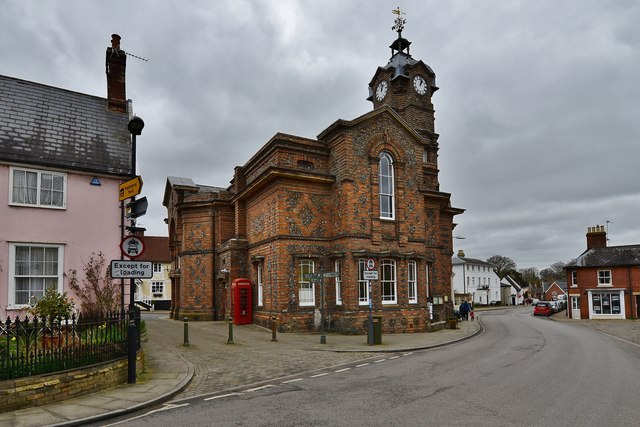When visiting Eye, you can be sure of a warm welcome. It is, however, one of the smallest towns in Suffolk. There are few Italianate Town Halls in Suffolk, but Eye is home to one of them, which was created in 1857 and has a clock tower that was once employed to incarcerate local lawbreakers. This charming market town has many unusual and captivating structures certainly worth visiting.
The village of Eye (named after the Old English word for ‘island’) would have been surrounded by water and marsh, with just St Paul and St Peter’s Church and Castle on higher ground.

The church is worth visiting; it was built in 1470 and still stands today. There is a 15th-century wooden rod screen with detailed carving, as well as portraits of kings, bishops, and saints. The Tower of the church is still a wonder of Suffolk, standing at over 101 feet/30 metres high, and gives some idea of the bright colours that would have been seen in the Middle Ages, despite the fact that the paintings have become faded.
During this period of economic growth in East Anglia, rebuilding churches on existing sites was common practice. It is difficult to comprehend now, but in the 15th and 16th centuries, East Anglia, aside from London, was the richest and most populous area in England, thanks largely to the wool and cloth business and the region’s advantageous location facing the Low Countries across the sea.
Among the appealing things about Eye is the combination of architectural styles and building materials in such a small region. For example, you will see the Red House, which has a 19th-century red brick façade covering a timber-framed house. The once-popular Horseshoes pub on Castle Street has a rather daring purple brick facade.

The way the building looks is typical of the area, with funds spent on the façade and little else. Recently restored almshouses (pictures below) are situated in Lambseth Street, replacing older almshouses built in 1636. The blue brickwork and stone canopies adorning these Victorian almshouses are typical of the period.
The White Lion Hotel, whose frontage dominates the small marketplace, was converted into a row of houses and flats in 1987. An arched sign over the gateway into its yard still advertises it as a posting establishment.
The building known as Eye Guildhall was built during the late 15th century and may have been bequeathed by John Upson “for the good of his soul.” Despite the Victorian ‘improvements,’ the structure still has two arched window heads that are still intact, along with its carved medieval-inspired Archangel Gabriel figure. In addition, there are a few thatched cottages framed with timber that remain in Eye, a typical sight in Suffolk.

After the Norman conquest of England in 1066, William Malet, Eye’s first Lord, built Eye’s Castle, which stands beside the church. His son, Robert, finished the castle and also founded Eye Priory. Between 1215 and the 17th century, the castle functioned as a prison; however, by the 18th century, only a small amount of stone remained, thanks to local scavengers. On the motte’s northwest side, where a tower once stood, you can still see the remnants of the original structure. The Castle is a good place to view the landscape north towards Norfolk, as the terrain is elevated.
Suffolk women were at the forefront of the Suffragette movement prior to World War I. A militant suffragette called Margaret Thompson worked with Emily Pankhurst and lived at Linden House, a 17th-century brick house on Lambseth Street in Eye.
In addition to its historic buildings, Eye boasts a diverse assortment of independent stores, including several interior and antique shops, a gift and card shop, a delicatessen, two Co-ops, as well as two butchers, and other convenience stores. You can find just about anything in this tiny community!
Eye is a nice place to stay if you want to visit Suffolk’s cities, including Ipswich and Norfolk, which are both just 15 minutes away by car.

